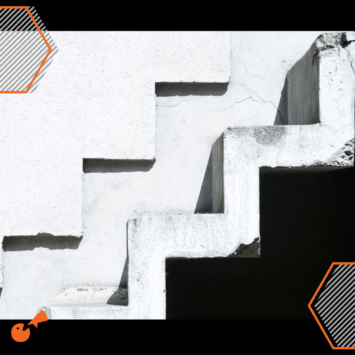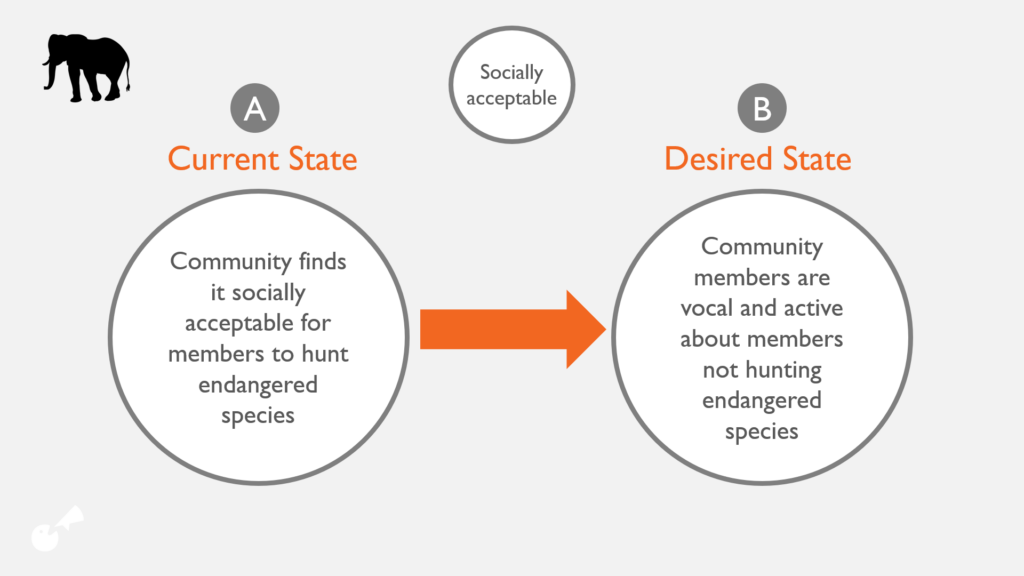
Our audiences don’t go from point A to point B
Our audiences don’t go from point A to point B
When designing a behavior change strategy, the first big step is to clearly define what we need people to do.
Great, now we’ve defined our desired end point. Let’s call that point B.
As a next step, it can be helpful to define where we’re at now. Meaning, the audience’s current state of behavior.
What are they doing that’s counter-productive for the conservation goal, or what are they not doing at the level or frequency that’s needed to achieve impact?
That current state of behavior is our starting point. Let’s call that point A.
Here’s an example of what this might look like for sustainable hunting:
Now we have our behavior change plan!
Get the audience from point A to point B, right?
But our audience doesn’t just JUMP from their current state to our desired state.
Although, I know we REALLY wish they would.
Instead, individuals travel through a series of steps as they transition from the current behavior towards the desired behavior.
This forms the behavior journey.
Some of these steps are ones the audience takes to make progress towards achieving the desired behavior.
Using the behavior change goal of reducing food-waste at home, these steps could include:
- Create a weekly meal plan and shopping list
- Properly store food to extend its shelf life
- Cook recipes that use up the ingredients before they go bad
- Compost or freeze food scraps
Already, these steps begin to form a more comprehensive behavior journey.
You can also include steps from your outreach plan that supports and encourages the desired behavior. Such as:
- Join the webinar to learn about easy food-saving tactics
- Download the meal planning guide for smarter shopping
- Check Pinterest for waste-less recipes
- Share a photo of what you cooked on Instagram
Breaking down points A and B into smaller steps helps us paint a clearer picture of what the behavior transition looks like from the audience’s perspective.
Once the behavior journey has been developed, we can then identify where in the process tangible and psychological barriers are likely to surface and when motivators are needed most.
Defining and designing this journey is critical to behavior change projects.
Creating the behavior change journey pushes us to have empathy for the audience from the get-go, as the most effective journeys reflect the audience’s perspective and process.
We have to put ourselves in our audience’s shoes to fully appreciate how change occurs, and what support and solutions are needed along the way.
It also gives us a solid foundation for making strategic decisions on where to allocate resources and energy.
Trade-offs may be needed due to budget, capacity, or time constraints. Our desire will be to try and do it all, even if available resources make it nearly impossible to do so.
Rather than spreading ourselves too thin, we can focus on a key portion of the behavior journey to effectively move the needle towards change.
Additionally, the behavior journey forces us to recognize that getting the audience from point A to point B does not happen overnight. It will be a transition for them, which means we should be ‘in it’ for the long haul.
We will be moving segments of the audience through different phases of the journey regularly, helping them stay motivated until the behaviors become part of their daily habit.
On top of that, we’ll be constantly recruiting new segments into the journey so that we expand and grow the movement.
Feeling jazzed about journeys?
Behavior journeys form the backbone of the Making Moves methodology.
Truth be told, it didn’t always; I had my own behavior change journey with journeys.
The first behavior journey gets created in Lesson 1 (right out the gate!) and then gets refined, tailored, and relied upon to craft strategies, outreach plans, and messages that motivate action and change.
Here is what a few recent cohort participants shared with me when submitting their first draft behavior journeys for review:
“Though we are doing some activities already, including interactive training and educational outreach events based on our current communication strategy, I took this opportunity to identify gaps in the strategy and get better insights on how to effectively communicate to change behaviors of our target audience.”
“I’m still in the beginning of my journey on my project to work with communities and tourists to increase compliance regarding wildlife interactions in the Brazilian Amazon. I’m happy that I’m developing the behavior journey now, as I believe it will guide my next steps in a more objective way.”
Some folks are even featuring their behavior journeys in applications for additional project funding! What better way to show that you’ve got a plan for achieving behavior change.
If this sounds like fun, then consider joining the next cohort. More details are here.
I hope to see you there (if I haven’t already!)




